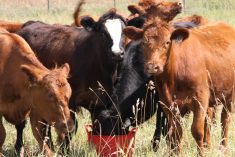CLAVET, Sask. — The University of Saskatchewan’s Livestock and Forage Centre of Excellence is being hailed as a world-class complex of field and science laboratories that is expected to trail blaze innovative research, hands-on learning and teaching, and industry engagement in all aspects of livestock and forage production on the Prairies.
The $38 million facility, which took five years to develop, officially opened Oct. 9.
Livestock producers made up the vast majority of the 300 people who toured the state-of-the-art barns, feedlot, cattle handling, research and teaching labs following opening ceremonies.
Read Also

Animal protection delivery to change in Saskatchewan
The Saskatchewan government is looking for a new agency to handle animal welfare after Animal Protection Services of Saskatchewan decided not to renew its contract next year.
“It will allow us to continue to do the research to make farming and especially ranching profitable going into the future, and incorporating forages into that research centre is absolutely key to that,” said Aaron Ivey, co-chair of the livestock and forge steering committee.
“It’s going to take those animals right from the time we developed the grass and the plant breeders and incorporating all of that into the feeding and the harvesting of the animals themselves,” said Ivey, a producer from Ituna, Sask.
As the university’s Saskatchewan Beef Industry Chair since 1992, John McKinnon was instrumental in making the new centre a reality.
To both of their surprise, McKinnon and the Termuende family (after which the Termuende Research Ranch near Lanigan, Sask., is named) were honoured with road signs bearing their names, which will be used at the new facility.
“It was the last thing I was expecting. It’s an unbelievable honour, it really is,” said McKinnon.
He said one of the biggest advantages with the new centre is the ability for different schools, industry and individuals to communicate and collaborate in order to promote an integrated and faster approach to solving industry issues, including emerging questions facing the livestock and forage industries.
The centre will operate three units on its 27 quarters of land:
- Beef Cattle Research and Teaching Unit, which includes a 1,500 head capacity feedlot and intensive environmental monitoring
- Forage and Cow-Calf Research and Teaching Unit, which includes 300 breeding cows
- Goodale Research Farm, which includes 165 breeding cows as well as horses, bison and deer for research
















